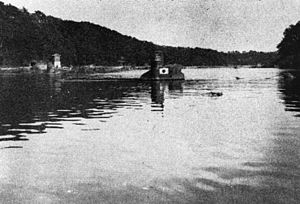- Japanese Special Attack Units
-
During World War II, Japanese Special Attack Units (特別攻撃隊 tokubetsu kōgeki tai?, often abbreviated to 特攻隊 tokkōtai), also called shimbu-tai, were specialized units of the Imperial Japanese Navy and Imperial Japanese Army normally used for suicide missions. They included kamikaze bombers, Fukuryu ("Crouching Dragon", suicide scuba divers), and several types of suicide ships and submarines.
Contents
Aircraft
Rocket plane Ohka
 Ohka at the Yasukuni Shrine
Ohka at the Yasukuni Shrine
The Yokosuka MXY-7 Ohka (桜花 "cherry blossom") was a purpose-built kamikaze aircraft employed by the Imperial Japanese Navy Air Service towards the end of World War II. The US gave the aircraft the Japanese name Baka ("idiot").
It was a small flying bomb that was carried underneath a Mitsubishi G4M "Betty", Yokosuka P1Y Ginga "Frances" (guided Type 22) or planned Heavy Nakajima G8N Renzan "Rita" (transport type 43A/B) bomber to within range of its target; on release, the pilot would first glide towards the target and when close enough he would fire the Ohka's engine(s) and dive against the ship to destroy. That final approach was almost unstoppable (especially for Type 11) because the aircraft gained tremendous speed. Later versions were designed to be launched from coastal air bases and caves, and even from submarines equipped with aircraft catapults, although none were actually used this way.
Shinryu
The Mizuno Shinryu (神龍 - "Divine Dragon") was a proposed rocket-powered kamikaze aircraft designed for the Imperial Japanese Navy towards the end of World War II. It never reached production.
Tsurugi
The Nakajima Ki-115 Tsurugi (剣 "Sword") was a one-man kamikaze aircraft developed by the Imperial Japanese Army Air Force in the closing stages of World War II in late 1945.
Baika
The Kawanishi Baika (梅花 - "Ume Blossom") was a pulsejet-powered kamikaze aircraft under development for the Imperial Japanese Navy towards the end of World War II. The war ended before any were built. The design was greatly inspired by the manned version of the German V1 flying bomb, the Fieseler Fi 103R "Reichenberg".
Boats
The Shinyo (震洋 "Sea Quake") were Japanese suicide boats developed during World War II. They were part of the wider Special Attack Units program. These fast motorboats were driven by one man, to speeds of around 30 kn (56 km/h; 35 mph). They were typically equipped with two depth charges as explosives.
Around 6,200 Shinyo were produced for the Imperial Japanese Navy and 3,000 Maru-Ni for the Imperial Japanese Army. Around 400 were affected to Okinawa and Formosa, and the rest were stored on the coast of Japan for the ultimate defense against the invasion of the Home islands.
Submarines
Kaiten
Kaiten manned torpedoes, stacked on top of a departing submarine.
The Kaiten (Japanese: 回天 "Change the World") was a torpedo modified as a suicide weapon, and used by the Imperial Japanese Navy in the final stages of World War II. Kaiten means returning to the heavens.
Early designs allowed for the pilot to escape after the final acceleration towards the target, although whether this could have been done successfully is doubtful. There is no record of any pilot attempting to escape or intending to do so, and this provision was dropped from later production kaitens.
Kairyu
 A Kairyu in the Aburatsubo inlet.
A Kairyu in the Aburatsubo inlet.
The Kairyu (海龍 "Sea Dragon") was a class of kamikaze midget submarines of the Imperial Japanese Navy, designed in 1943-1944, and produced from the beginning of 1945. These submarines were meant to meet the invading American Naval forces upon their anticipated approach of Tokyo.
These submarines had a two-man crew and were fitted with an internal warhead for suicide missions. Over 760 of these submarines were planned, and by August 1945, 200 had been manufactured, most of them at the Yokosuka shipyard.
Divers
Suicide divers (Japanese: 伏龍, Fukuryu "Crouching dragons") were a part of the Special Attack Units prepared to resist the invasion of the Home islands by Allied forces. They were armed with a mine containing 15 kg (33 lb) of explosive, fitted to a 5 m (16 ft) bamboo pole. They would dive and stick the pole into the hull of an enemy ship, destroying themselves in the process. They were equipped with a diving jacket and trousers, diving shoes, and a diving helmet fixed by four bolts. They were typically weighed down with 9 kg (20 lb) of lead, and had two bottles of compressed air at 150 bars. They were expected to be able to walk at a depth of 5 to 7 m (16 to 23 ft), for about six hours. This new weapon is only known to have been used a few times operationally:
- January 8, 1945: Damage by suicide divers to Infantry landing craft (gunboat) LCI(G)-404 in Yoo Passage, Palaus.
- February 10, 1945: Attempted attack by suicide divers on surveying ship Hydrographer (AGS-2) in Schonian Harbor, Palaus.
Several deaths occurred during training due to malfunctions.
See also
- Chiran Special Attack Peace Museum
External links
- Japanese suicide weapons
- O'Neill, Suicide Squads - book that describes Japan's various types of special attack units
- Kamikaze Images - web site that covers all types of Japan's special attack forces
 Categories:
Categories:- Military history of Japan during World War II
Wikimedia Foundation. 2010.


